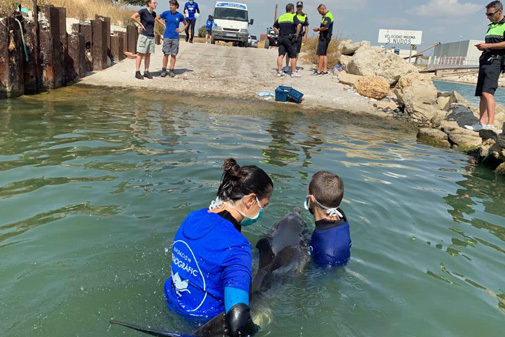The most lethal and dangerous virus for wild cetaceans is called morbillivirus and is circulating throughout the Mediterranean killing dolphins in the Valencian Community and also in Sicily. According to scientists from the Oceanogràfic Foundation and the Sperimentale della Sicilia Zooprophylactic Institute, the same pathogen detected in the Valencian Community has killed seven dolphins in Sicily.
"Dolphin morbillivirus is now the deadliest pathogen for cetaceans," explains Consuelo Rubio-Guerri, Research Coordinator of the Oceanogràfic Foundation . "In wild animals it is very difficult to control the action of such a pathogen, so that we do not plan to develop a vaccine or a specific treatment for now , but it is important to know as much as possible about the disease and its evolution," he says.
In the last quarter of the century, different variants of this pathogen have caused massive epidemics with high mortality throughout the world, of which the most serious, in 1988 , ended approximately half of the bottlenose dolphins of the American Atlantic.
A paper published in the journal Scientific Reports confirms the presence of the new strain of the virus in Sicily and underlines "the need for more research to determine not only how this dolphin morbillivirus strain circulates, but also its potential impact on cetacean populations that inhabit the Mediterranean . "
The morbillivirus of cetaceans was first described in 1990. It was then confirmed that the large mass mortality of bottlenose dolphins observed on the American Atlantic coast in the late 1980s was due to this pathogen, and not, as initially thought, to a toxic agent, a contaminant. Stranded animals showed symptoms of a strange condition that combined pneumonia , encephalitis and damage to the immune system .
In the last 25 years several strains of morbillivirus have caused numerous massive stranding. In 1990, a thousand dolphins were listed in the Mediterranean , and shortly after about a hundred bottlenose dolphins in the Gulf of Mexico. Other episodes in the Mediterranean, between 2007 and 2011, again affected several hundred dolphins listed.
However, since 2011 these large mass deaths had not been repeated, although there have been several isolated cases in which the disease has also shown an especially devastating effect on animals . Last year, the analyzes carried out by Rubio-Guerri to five dolphins collected on the Valencian coast helped explain the pattern change in the disease: these animals, killed as isolated cases instead of a large epidemic, had been infected by a strain of the new virus in the Mediterranean, most likely introduced by animals from the Atlantic .
Then the researchers postulated that the strain was already settled circulating throughout the Mediterranean. Now, the new dolphins to the seven dead dolphins in Sicily confirms this hypothesis. As the researchers explain in Scientific Reports , the strain that killed these dolphins shows "substantial differences" with that detected in epidemics in the Mediterranean in 1990, 2007 and 2011 , while its resemblance to variants found in the Atlantic in 2007, 2011 and 2013, and with the strain detected in Valencian cases, it is "surprising".
Scientists still do not know why the new strain does not cause epidemics , although it is more aggressive in affected individuals. One possibility is that most dolphins, but not all, already have some immunity against this strain.
According to the criteria of The Trust Project
Know more- Science and Health
- science
Environment America has lost one in four birds in the last 50 years
ClimateMillions of people participate in climate strikes today
Meteorology: A summer of records will lead to a warmer autumn than usual

